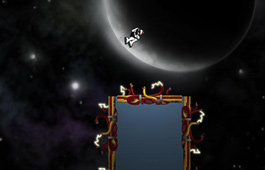A Life of Games
March 14, 2011

Evan M. Skarin ’09 (front, left)
was standing on a Las Vegas ballroom stage with a smile almost as big as
the oversized check he was holding. In less than two years, his development team
had gone from being aspiring game designers in Southern Methodist University’s
Guildhall program to award-winning game designers at February’s Indie Game
Challenge (IGC), the largest independent game design competition in the world. Team
Hermes’ Inertia had won nearly every
category for which it was nominated, earning the team more than $100,000 and
one heck of an introduction to the industry. At that moment, it seemed possible
that Skarin’s future, like his game’s leaping hero, could defy gravity.
Inertia is a simple game. You help spacesuit-clad Hermes navigate labyrinthine levels filled with seemingly impassable dangers. There is no princess to save, and no high score to beat. Only one thing separates Inertia from thousands of other games with running and jumping protagonists: Hermes can suspend gravity at will.
 The concept is so
straightforward that it’s hard to appreciate Inertia’s complexity until you see it in motion. Jumps break free
from simple arcs or straight lines, allowing for – and requiring – twisting,
bouncing combinations. At the game’s core is a single idea executed very, very
well.
The concept is so
straightforward that it’s hard to appreciate Inertia’s complexity until you see it in motion. Jumps break free
from simple arcs or straight lines, allowing for – and requiring – twisting,
bouncing combinations. At the game’s core is a single idea executed very, very
well.
“[Coming up with] the idea for Inertia was a slow process,” Skarin says. “We only had a couple weeks to come up with the concept, and I can remember sitting in a design meeting two days before our deadline without a set game. We had lots of ideas, but nothing really felt right. We just refused to settle for the classic ‘platformer’ game play.
“One day, we had an awesome brainstorming session, and the anti-gravity mechanic for Inertia was born. It was never intended to be an entirely new design for platformers, and we never thought, ‘Well, we need to compete with all the other top indie games out there.’ Our own ambition and great ideas essentially gave birth to an easy-to-learn mechanic that is difficult to master.”
As Team Hermes’ leader, Skarin guided Inertia from whiteboard scribbles to downloadable product. It was his first shot at organizing a project of such size, but he entered SMU’s graduate program prepared to juggle the different facets of development. Throughout his four years at DePauw, Skarin tailored his studies to game design. He often asked professors outside of his psychology major to let him into classes about game-related subjects, such as mathematics and film.
“Game design is composed of many disciplines,” Skarin says. “Psychology, programming, art, creative writing and philosophy are just some subjects that directly correspond to skills needed to design games. That’s the true beauty of a liberal arts education – being exposed to a variety of different subjects. Game designers are successful based on their ability to keep games fresh with new ideas. Being exposed to as many subjects as possible ultimately allows you to be more creative and to think about the world differently.”
If classes didn’t already exist, Skarin created them. When he discovered that Harry J. Brown, an associate professor of English, studied games and had even written a book about their use in education, Skarin approached him to work on an independent study course. Together, they deconstructed games, talked game design philosophy and debated modern design conventions.
 “It was an awesome experience and really
helped me make the leap in choosing game design as my profession,” Skarin says.
“It was an awesome experience and really
helped me make the leap in choosing game design as my profession,” Skarin says.
Inertia’s victories at IGC brought immediate job offers to most of the development team, who graduated from their design program in December. Though he hasn’t decided which offer he’ll take, Skarin will soon enter an industry much different than it was just a decade ago.
Lifelong game players are growing up, and so are their tastes. They now seek games that expand the medium, challenging film and literature as art meant to be taken seriously. Many have decided to play a prominent role in that transformation, whether in development, like Skarin, or by bringing the medium into the classroom, as Professor Brown has done. Recently, critic Roger Ebert rejected the idea that games are – or could ever be – art, and many others reduce them to being puerile timesinks. Skarin hopes to prove them wrong.
“Every new medium has faced animosity,” he says. “I got into this industry because I believe in what games can be.”
